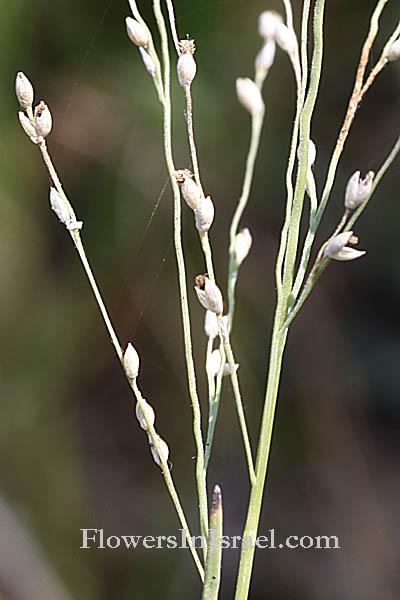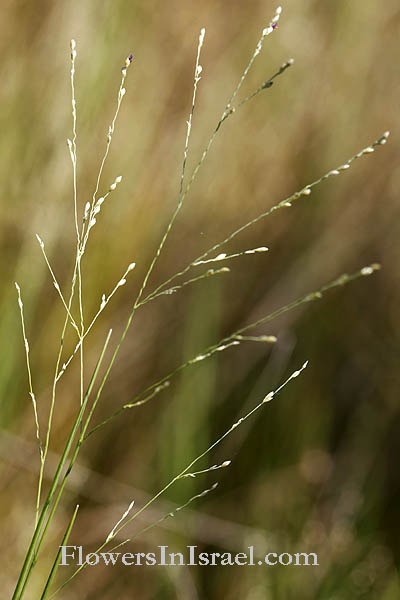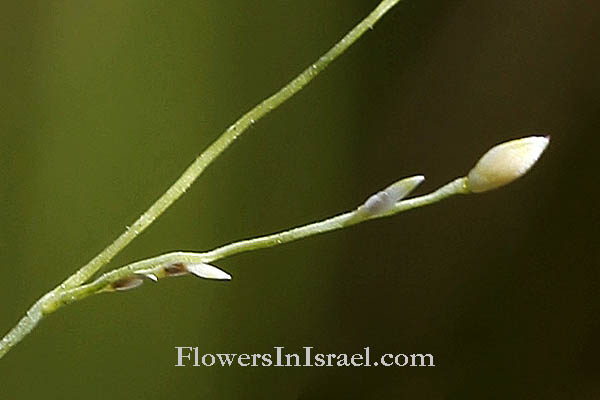Panicum gouinii, Torpedo grass, Quack grass,
Bullet grass, Couch panicum,
Hebrew: דוחן זוחל, Arabic: الثمام الزاحف, Egypt: زمار "Zommar"
"But as for you, take wheat, barley, beans, lentils, millet and spelt,
put them in one vessel and make them into bread for yourself..."
Ezekiel 4:9
| Scientific name: | Panicum repens L. | |
| Synonym name: | Panicum airoides R.Br., Panicum littorale C.Mohr ex Vasey, Panicum gouinii Fourn. | |
| Common name: | Torpedo grass, Quack grass, Bullet grass, Couch panicum | |
| Hebrew name: | דוחן זוחל | |
| Arabic name: | الثمام الزاحف | |
| Egypt: | زمار "Zommar" | |
| Family: | Graminea (Poaceae), Grass Family, משפחת הדגניים |

Location: Netanya, the Dora rain pool |
| Life form: | chamaephyte, hemicryptophyte, rhizomatous perennial | |
| Stems: | culms erect, to 80 cm high, rigid, many noded | |
| Leaves: | Alternate, entire, smooth, hairy leaf sheaths and hair on the upper margins of the leaves. Leaf blades are stiff, linear, flat or folded; the surface often with a waxy or whitish coating | |
| Inflorescence: | panicle, 7-22 cm long | |
| Flowers: | Spikelet with 2 florets; upper glume and lower lemma acute; upper lemma smooth | |
| Fruits / pods: | Grain | |
| Flowering Period: | January, April, May, June, July, August, September, October, November, December | |
| Habitat: | Humid habitats | |
| Distribution: | Mediterranean Woodlands and Shrublands, Semi-steppe shrublands, Shrub-steppes, Deserts and extreme deserts | |
| Chorotype: | Subtropical -Tropical | |
| Summer shedding: | Perennating |

Location: Netanya, the Dora rain pool Derivation of the botanical name: Panicum, panus (Latin), "millet", annual and perennial grasses that have 1- to 2-flowered spikelets arranged in a panicle (Latin panicula, diminutive of panus). repens, repo, "to crawl, creep"; meaning creeping. airoides, like the genus Aira. littorale, of the sea shore; littoral. gouinii, in honor of Dr. François-Marie-Gabriel Goüin (1818-1873), a surgeon in the French navy and an amateur plant collector, who collected in Mexico in 1864-1867. The Hebrew name: דוחן, dochan is used for "millet" in Ezekiel 4:9.
H.B.Tristram, The Natural History of the Bible: "Millet, heb. dôchan, is only once mentioned among ingredients which Ezekiel was commanded to take and mingle for his bread: "Take thou also unto thee wheat, and barley, and beans, and lentils, and millet, and fitches, and put them in one vessel, and make thee bread thereof" (Ez.iv.9), where it is evident that every grain is enumerated, which was ordinarily used for bread". 
Location: Netanya, the Dora rain pool |